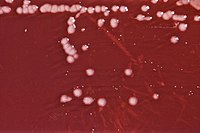
Comparison of MALDI-TOF MS Biotyper and 16S rDNA sequencing for the identification of Pseudomonas species isolated from fish.
Sign Up to like & getrecommendations! Published in 2019 at "Microbial pathogenesis"
DOI: 10.1016/j.micpath.2019.04.024
Abstract: Effective and reliable methods of identification of Pseudomonas species are important for the characterization of microorganisms. Freshwater ecosystems are an important source of Pseudomonas species, including those pathogenic to fish and humans. The aim of… read more here.
Keywords: 16s rdna; pseudomonas; identification pseudomonas; identification ... See more keywords

Comparative growth responses of Amaranthus [L.] species in Humus and Ferruginous Ultisols using plant growth promoting Rhizobacteria (Pseudomonas species)
Sign Up to like & getrecommendations! Published in 2021 at "South African Journal of Botany"
DOI: 10.1016/j.sajb.2020.09.029
Abstract: Abstract The study investigated the possibility of growth-promoting rhizobacteria to enhance plant growth capacities of Amaranthus hybridus and A. viridis in ferruginous ultisols comparative to humus. The experimental setup was divided into two groups; the… read more here.
Keywords: promoting rhizobacteria; plant growth; growth promoting; growth ... See more keywords

KaiC-like proteins contribute to stress resistance and biofilm formation in environmental Pseudomonas species.
Sign Up to like & getrecommendations! Published in 2022 at "Environmental microbiology"
DOI: 10.1111/1462-2920.16330
Abstract: KaiC is the central cog of the circadian clock in Cyanobacteria. Close homologs of this protein are widespread among nonphotosynthetic bacteria, but the function, interaction network, and mechanism of action of these proteins are still… read more here.
Keywords: species kaic; environmental pseudomonas; stress resistance; kaic homologs ... See more keywords

Pseudomonas species may appear strikingly filamentous in tissue sections: an important consideration for surgical pathologists and a reminder of the utility of modified silver impregnation methods
Sign Up to like & getrecommendations! Published in 2022 at "Histopathology"
DOI: 10.1111/his.14811
Abstract: Although tissue culture is the gold standard for diagnosing infection, histologic examination of surgically resected tissue can be a critical component in the diagnosis of tissue infection. The goal of this brief report is to… read more here.
Keywords: strikingly filamentous; pathology; pseudomonas species; appear strikingly ... See more keywords

Xylose-Inducible Promoter Tools for Pseudomonas Species and Their Use in Implicating a Role for the Type II Secretion System Protein XcpQ in the Inhibition of Corneal Epithelial Wound Closure
Sign Up to like & getrecommendations! Published in 2020 at "Applied and Environmental Microbiology"
DOI: 10.1128/aem.00250-20
Abstract: Pseudomonas species are enormously important in human infections, in biotechnology, and as model systems for investigating basic science questions. In this study, we have developed a xylose-inducible promoter system, evaluated it in P. aeruginosa and… read more here.
Keywords: system; xylose inducible; promoter; gene ... See more keywords

Whole-Genome Sequencing-Based Re-Identification of Pseudomonas putida/fluorescens Clinical Isolates Identified by Biochemical Bacterial Identification Systems
Sign Up to like & getrecommendations! Published in 2022 at "Microbiology Spectrum"
DOI: 10.1128/spectrum.02491-21
Abstract: Most of the clinical isolates, identified as P. putida or P. fluorescens, were misidentified in clinical laboratories. Whole-genome sequencing (WGS) revealed that these isolates belonged to different Pseudomonas species, including novel species. WGS is a… read more here.
Keywords: clinical isolates; putida fluorescens; whole genome; identification ... See more keywords

A Unique Homo-Hexameric Structure of 2-Aminomuconate Deaminase in the Bacterium Pseudomonas species AP–3
Sign Up to like & getrecommendations! Published in 2019 at "Frontiers in Microbiology"
DOI: 10.3389/fmicb.2019.02079
Abstract: The bacterium Pseudomonas species sp. AP–3 is one of several microorganisms that are capable of using 2-aminophenol as its sole source of carbon, nitrogen and energy. Several 2-aminophenol-metabolizing enzymes have pivotal roles in the biodegradation… read more here.
Keywords: pseudomonas; amne; structure; bacterium pseudomonas ... See more keywords

Assessing the Orthogonality of Phage-Encoded RNA Polymerases for Tailored Synthetic Biology Applications in Pseudomonas Species
Sign Up to like & getrecommendations! Published in 2023 at "International Journal of Molecular Sciences"
DOI: 10.3390/ijms24087175
Abstract: The phage T7 RNA polymerase (RNAP) and lysozyme form the basis of the widely used pET expression system for recombinant expression in the biotechnology field and as a tool in microbial synthetic biology. Attempts to… read more here.
Keywords: rna; phage; orthogonality; pseudomonas species ... See more keywords